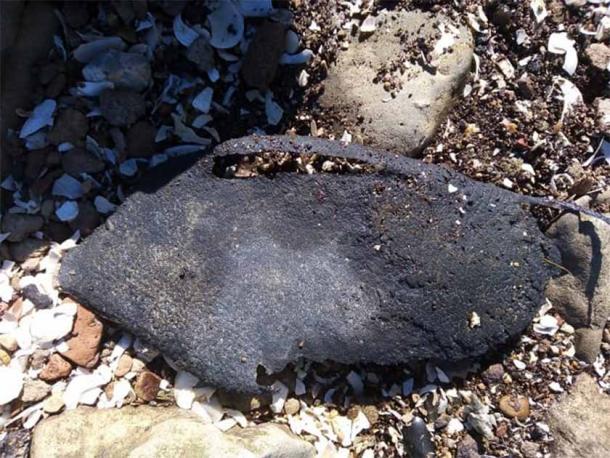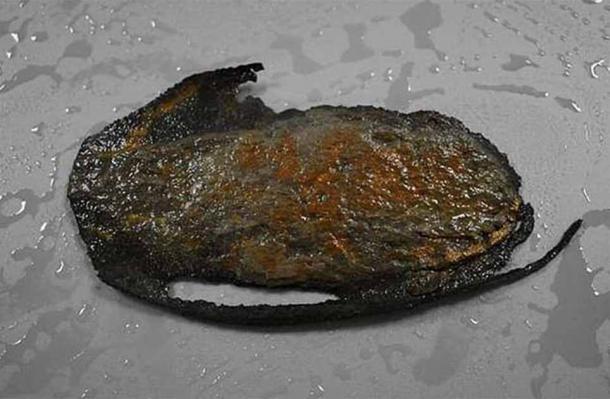A man exploring along a riverbank in northern Kent recently discovered the oldest shoe ever found on United Kingdom soil. Carbon dating tests proved the decayed but still recognizable leather artifact was nearly 3,000 years old, having been manufactured sometime between the years 888 and 781 BC. This incredible age highlights what an absolute miracle this discovery was, as the ancient shoe, which likely belonged to a toddler, was lying out in the open fully visible to anyone who might walk by.
One of the Best Mudlarking Adventures Ever
The small, flattened shoe was spotted by archaeologist Steve Tomlinson, a resident of Ramsgate, Kent who works with the Canterbury Archaeological Trust.
On September 17, 2022, Tomlinson and a colleague, archaeologist Emily Brown, were out walking along rivers in Kent, searching for valuable artifacts that might have washed up along the edges. This activity is known as mudlarking, and archaeologists who do it often find intriguing objects that may be anywhere from a few decades to a few centuries old. The best sites for mudlarking are rivers that feed into the ocean (like the River Thames , for example) and are affected by the rising and sinking of the tides. Mudlarkers will arrive during times of low tide, searching along shores that are normally covered by water.
 Mudlarking the Thames: How a Riverbed Became the World’s Biggest Archaeological Site
Mudlarking the Thames: How a Riverbed Became the World’s Biggest Archaeological Site The Havering Hoard: Baffling Bronze Age Artifacts Found in London
The Havering Hoard: Baffling Bronze Age Artifacts Found in London

The unassuming ‘thing’ on the river beach didn’t slip past finder Steve’s trained eye ( Steve Tomlinson )
Someone with an untrained eye might have passed by the shoe without noticing it, or even caring if they did notice. But Tomlinson was actively searching for anomalous objects, and the aged shoe caught his attention immediately.
“The day started well, and between us we had a good selection of finds including plenty of pottery sherds from the Roman period, and various small objects like a small piece of Roman tesserae,” Tomlinson recalled in an article in the Isle of Thanet News :
“We had been out for 3 hours scouring the shoreline, and the tide was turning when we hit the last leg of our day. As we made our way along the foreshore … I came across what looked like a very old shoe-like piece of leather washed up on the mud. It was around 15 centimeters [6 inches] in length.”
Tomlinson and Brown examined the weathered leather of the flattened shoe carefully, trying to estimate its age. The archaeologists concluded that it was most likely an early medieval artifact, meaning it might have been dropped or washed into the river as long as 1,000 years ago.
It might seem unusual that someone finding a shoe next to a river would conclude the object was centuries old. But this wasn’t Tomlinson first time. While mudlarking in 2018, he discovered an Anglo-Saxon shoe sticking out of the mud that was ultimately dated to the 10th century AD.
Expecting a similar result this time, Tomlinson sent his interesting discovery on to the SUERC carbon dating facility in East Kilbride, Scotland. But when the lab revealed the results five weeks later, Tomlinson received one of the great shocks of his life, as he learned he’d underestimated the age of the little old shoe by nearly 2,000 years.
“The date they had given me was just astonishing,” Tomlinson said. “This could be not only the oldest shoe found in Kent, but in the British Isles itself, and a very high possibility that this is also the smallest Bronze Age shoe ever discovered in the world.”
It has now been confirmed that this is the most ancient shoe ever recovered in the United Kingdom. This distinction previously belonged to a 2,000-year-old shoe found in 2005 in a quarry in Somerset.
By modern standards the shoe would be listed as a child size 7, and would be appropriate for a toddler aged around 2-3 years old, explained Mr Tomlinson. The child presumably had lost the shoe while playing in or around the riverbank all those years ago, and it had been lying on the bottom of the riverbank waiting to be found ever since.

The shoe has been conserved by Dana Goodburn Brown, an accredited Archaeological Conservator at DGB Conservation . (Steve Tomlinson )
Walking Back in Time in a Bronze Age Toddler’s Shoe
Archaeologists are always surprised and delighted when they find ancient items of clothing that are in good enough shape to be studied.
“Prehistoric textiles like this rarely survive and the only chance is by finding them in anaerobic conditions such as bogs and mud (away from the air),” Tomlinson explained.
But even when an organic artifact is preserved for hundreds or thousands of years, it still takes a lot of luck to actually locate it. And Steve Tomlinson was blessed with an inordinate amount of good fortune, as he fully appreciates.
“Finding something like that is quite extraordinary,” Tomlinson confirmed in an interview with Kent Online . “It opens up history too; we just know nothing about these kinds of things.”
The ancient toddler’s shoe will be transferred to the British Museum for more analysis. Now that the shoe has been successfully dated to the Late Bronze Age , it will be tested further to see if scientists can learn what animal it came from. Attempts will be made to extract traces of human DNA from the artifact as well, and if this is successful it could reveal the true age, gender and ethnic identity of the child who wore the leather shoe in the first millennium BC.
Sources:ancient-origins.net








